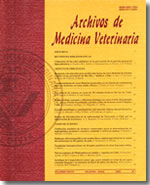Canine herpesvirus-1 detection in Chile
Main Article Content
Abstract
This work reports the detection of canine herpesvirus type 1 (CHV-1) in Chile, confirming the strong clinical suspicion of its existence. A viral isolate, RP5, was obtained from diagnosed clinical cases such as hemorrhagic diseases of puppies. This viral isolate was inoculated in cell monolayers and produced the typical cytopathic effect of members of the Alphaherpesvirinaesubfamily, Herpesviridae family: cellular lysis in a short period of time. This viral isolate demostrated its effect in primary cultures of canine lung and canine kidney, and also in the MDCK cell line. This effect was lost due to prior incubation of the inoculate with an organic solvent, therefore the adenovirus presence was ruled out. As a specific confirmation of VHC-1 presence, a direct fluorescence test in inoculated cell cultures was carried out using monoclonal antibody anti CHV-1, fluorescein isothiocyanate conjugated (VMRD, Inc.) whose results suggest the presence of the virus. It is of great importance to determine the presence of the virus because the isolation and characterization of the virus will allow to carry out future investigations. This includes the evaluation of the magnitude of infection in the canine population and obtaining information about virus infection repercussion in reproductive places. It may also the challenge of diagnostic design of laboratory methods such as immunofluorescence, Enzyme-Linked Immunosorbent Assay (ELISA) and Polymerase Chain Reaction (PCR). In addition it may possible to devise strategies in order to develop an eventual vaccine.

